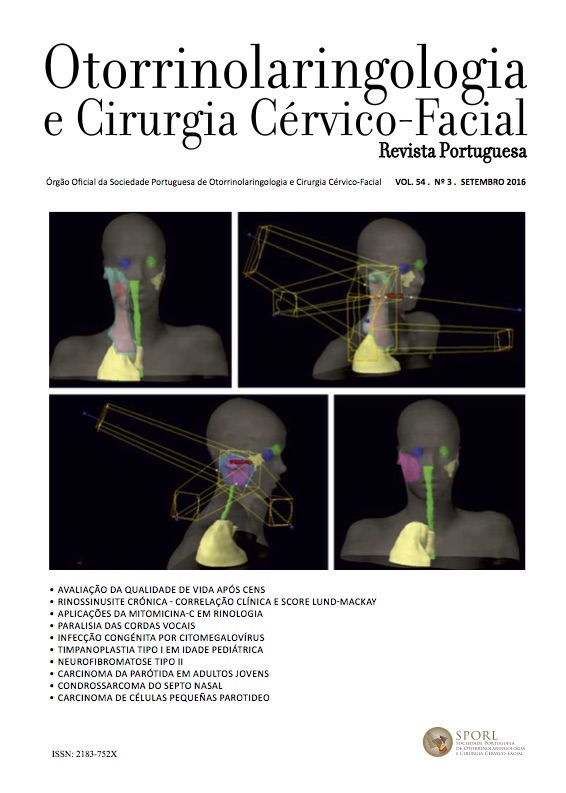Carcinoma of parotid gland in young adults - A case report
DOI:
https://doi.org/10.34631/sporl.622Keywords:
carcinoma, parotid gland, young adults, radiotherapy, surgeryAbstract
Seventy percent of salivary gland tumors arise in the parotid gland and 25% of those are malignant neoplasms. These tumors are rare in young adults and both its incidence and malignancy rate differ from adults and the prognosis is more favorable. We present a case to highlight the existence of this rare incidence, as well as the different therapeutic strategies and their controversies. This is a 19-year-old female patient, with a 4 cm swelling above the right parotid region and paresthesia in the right upper limb. Biopsy revealed a mucoepidermoid carcinoma of the parotid, so the patient was submitted to surgery and postoperative radiotherapy. Currently, she has a 42-month follow-up with no evidence of disease recurrence. Once the diagnosis of parotid carcinoma is rare in young adults, more studies will be necessary to optimize therapeutic strategies.
Downloads
References
Spiro J, Spiro, R. Cancer of the Parotid Gland: Role of 7th Nerve Preservation. World Journal Surgery. 2003; 27:863-867.
Halperin EC, Wazer DE, Perez CA, Brady LW. Perez and Brady’s Principles and Practice of Radiation Oncology, 6th Edition. Philadelphia, Lippincott-Williams & Wilkins; 2013: pp2350-2390.
Al-Naqeeb NI, Dashti H, Al-Muhanna AH, Behbehani A. Parotid gland tumours: a 15-year experience. Journal of the Royal College of Surgeons of Edinburgh. 1992; 37(2):89-93.
Diaz P, Castillo R, Plata M, Gías L et al. Clinical results in the management of Frey’s Syndrome with injections of Botulinum Toxin. Medicina Oral Patol Oral Cir Bucal. 2008; 13(4):E248-252.
Rutt AL, Hawkshaw MJ, Lurie D, Sataloff RT. Salivary gland cancer in patients younger than 30 years. Ear Nose Throat J. 2011; 90(4):174-84.
Meyers E, Ferris R. Salivary Glands Disorders. Springer 2007.
Armstrong JG, Harrison LB, Thaler HT, Friedlander-Klar H et al. The indications for elective treatment of the neck in cancer of the major salivary glands. 1992; Cancer 69:615.
Zbaren P, Schupbach J, Nuyens M, Stauffer E. Elective neck dissection versus observation in primary parotid carcinoma. Otolaryngol Head Neck Surg. 2005; 132:387.
Kelley DJ, Spiro RH. Management of the neck in parotid carcinoma. Am J Surg 1996; 172:695–7.
Nobis CP, Rohleder NH, Wolff KD, Wagenpfeil S et al. Head and neck salivary gland carcinomas - elective neck dissection, yes or no? J Oral Maxillofac Surg. 2014; 72(1):205-10.
Al-Mamgani A, Van Rooij P, Verduijn GM, Meeuwis CA et al. Long-term outcomes and quality of life of 186 patients with primary parotid carcinoma treated with surgery and radiotherapy at the Daniel den Hoed Cancer Center. Int J Radiat Oncol Biol Phys. 2012; 84(1):189-95.
Pohar S, Gay H, Rosenbaum P, Klish D et al. Malignant parotid tumors: Presentation, clinical/pathological prognostic factors, and treatment outcomes. Int J Radiat Oncol Biol Phys 2005; 61:112-118.
Terhaard CHJ, Lubsen H, Rasch CRN, Levendag PC et al. The role of radiotherapy in the treatment of malignant salivary gland tumors. Int J Radiat Oncol Biol Phys 2005; 61:103-111.
Richter SM, Friedmann P, Mourad WF, Hu KS et al. Postoperative radiation therapy for small, low-/intermediate-grade parotid tumors with close and/or positive surgical margins. Head Neck 2012; 34(7):953-5.
Stodulski D, Mikaszewski B, Stankiewicz C. Are all prognostic factors in parotid gland carcinoma well recognized? Eur Arch Otorhinolaryngol 2012; 269(3): 1019–1025.
Ghosh-Laskar S, Murthy V, Wadasadawala T, Agarwal J. Mucoepidermoid carcinoma of the parotid gland: factors affecting outcome. Head Neck 2011; 33(4):497-503.
Armstrong JG, Harrison LB, Spiro RH, Fass DE et al. Malignant tumors of major salivary gland origin. Arch Otolaryngol Head Neck Surg 1990; 116:290–293.
Terhaard CHJ, Lubsen H, Rasch CRN, Levendag PC et al. The role of radiotherapy in the treatment of malignant salivary gland tumors. Int J Radiat Oncol Biol Phys 2005; 61:103–111.
Terhaard CHJ, Lubsen H, Van Der Tweel, Hilgers FJ et al. Salivary gland carcinoma: independent prognostic factors for locoregional control, distant metastases, and overall survival: results of the Dutch Head and Neck Oncology Cooperative Group. Head Neck 2004; 26:681–693.
Therkildsen MH, Christensen M, Andersen LJ, Schiødt T et al. Salivary gland carcinomas-prognostic factors. Acta Oncol 1998; 37:701–713.
Fu KK, Leibel SA, Levine ML, Friedlander LM et al. Carcinoma of the major and minor salivary glands. Analysis of treatment results and sites and causes of failures. Cancer 1977; 40 (6): 2882-2890.
Poulsen MG, Pratt GR, Kynaston B, Tripcony LB. Prognostic variables in malignant epithelial tumors of the parotid. Int J Radiat Oncol Biol Phys 1992; 23:327–330.
Mendenhall WM, Morris CG, Amdur RJ, Werning JW et al. Radiotherapy alone or combined with surgery for salivary gland carcinoma. Cancer 2005; 103:2544–2550.
Chen WC, Liao CT, Tsai HC, Yeh JY et al. Radiation-induced hearing impairment in patients treated for malignant parotid tumor. Ann Otol Rhinol Laryngol 1999; 108(12):1159-1164.






